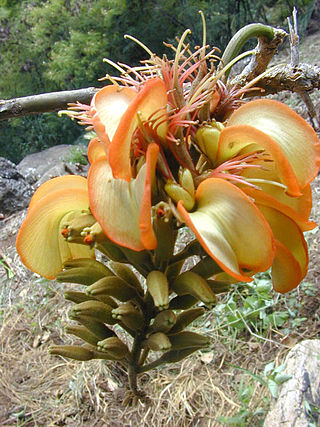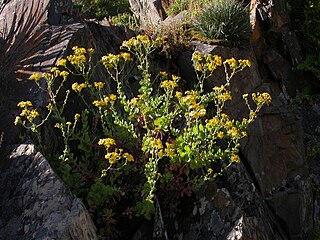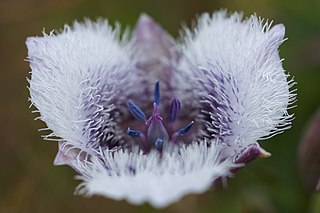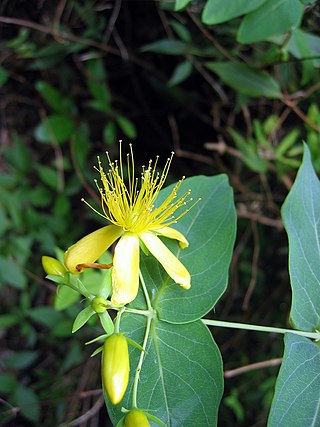
Charles Gaudichaud-Beaupré was a French botanist.

Wiliwili is a species of tree in the pea family, Fabaceae, that is endemic to the Hawaiian Islands. It is the only species of Erythrina that naturally occurs there. It is typically found in Hawaiian tropical dry forests on leeward island slopes up to an elevation of 600 m (2,000 ft).

George Arnott Walker Arnott of Arlary was a Scottish botanist. He collaborated with botanists from around the world and served as a regius professor of botany at the University of Glasgow. An orchid genus Arnottia was named in his honour in 1828.

Allium falcifolium is a North American species of wild onion known by the common name scytheleaf onion or coast flatstem onion. It is native to northern California and southern Oregon, where it grows in heavy, rocky soils, especially serpentine soils.

Grayia spinosa is a species of the genus Grayia in the subfamily Chenopodioideae of the flowering plant family Amaranthaceae, which is known by the common names hop sage and spiny hop sage. It is widely distributed across the Western United States, where it grows in a number of desert and mountain habitats.

Senecio glabratus is a species of the genus Senecio and family Asteraceae.

Senecio nigrescens is a species of the genus Senecio and family Asteraceae and was first written about in the botanical classic Botany of Beechey's Voyage to the Pacific and Behring's Straits.

Calochortus tolmiei is a North American species of flowering plant in the lily family known by the common names Tolmie's star-tulip and pussy ears. It was discovered by and named for Dr. William Fraser Tolmie.

Calochortus uniflorus is a species of flowering plant in the lily family known by the common names Monterey mariposa lily and large-flowered star-tulip. It is native to western Oregon and to California as far south as San Luis Obispo County. It grows in moist areas, such as meadows, in coastal hills and lower-elevation mountains. Most of the populations are found in the Coast Ranges, but some occur in the Cascades and in the foothills of the Sierra Nevada.

Senna gaudichaudii, also known by many common names, including kolomana in Hawaii and as blunt-leaved senna in Australia, is a species of flowering plant in the family Fabaceae and is native to some Pacific Islands including Hawaii, parts of Southeast Asia and Queensland in Australia. It is shrub or small tree with pinnate leaves, usually with three to five pairs of oblong to egg-shaped leaflets, and yellow flowers arranged in groups of four to ten, with ten fertile stamens in each flower.

Chaetymenia is a genus of flowering plants in the daisy family.

Hypericum grandifolium, the large-leaved St John's wort, is a species of flowering plant in the family Hypericaceae. The plant is a bushy shrub that can grow to almost 2 meters tall. It has large leaves, golden yellow petals, and seed capsules that split open. H. grandifolium is native to the Canary Islands and Madeira in Macaronesia, but has become invasive in other regions, including California, after escaping from cultivation as an ornamental plant. It is parasitized by wasps and fungi, and is capable of reproducing through its rhizomes.

Peperomia tetraphylla, known as the acorn peperomia or four-leaved peperomia, is a small plant in the Piperaceae family that grows natively in tropical and subtropical regions around the world. It has been introduced to Easter Island.
Sida mysorensis, common name in India Mysore fanpetals, is a plant species native to South and Southeast Asia. It has been reported from the wild in Indonesia, Vietnam, Laos, Cambodia, Thailand, India, Pakistan and southern China, and is cultivated elsewhere. It grows in grassy slopes, on roadsides, and in forest boundaries.

Bouvardia ternifolia, the firecracker bush, is a shrub widespread across much of Mexico, the range extending south into Honduras and north into the southwestern United States.

The Flora Antarctica, or formally and correctly The Botany of the Antarctic Voyage of H.M. Discovery Ships Erebus and Terror in the years 1839–1843, under the Command of Captain Sir James Clark Ross, is a description of the many plants discovered on the Ross expedition, which visited islands off the coast of the Antarctic continent, with a summary of the expedition itself, written by the British botanist Joseph Dalton Hooker and published in parts between 1844 and 1859 by Reeve Brothers in London. Hooker sailed on HMS Erebus as assistant surgeon.

Scaevola chamissoniana is a shrub in the family Goodeniaceae and its native range is the Hawaiian Islands, where it is known as the Mountain naupaka or Naupaka kuahiwi.

Scaevola gaudichaudiana, the mountain naupaka, is a perennial shrub in the family Goodeniaceae. The plant is endemic to Hawaii.

Peperomia leptostachya, commonly known as slender peperomia or hairy peperomia, is a small succulent herb in the pepper family Piperaceae found in most parts of the Paleotropic floristic kingdom, from Africa through Asia to Australia and the western Pacific.


















